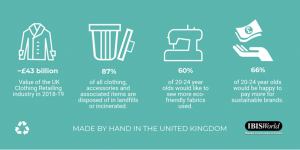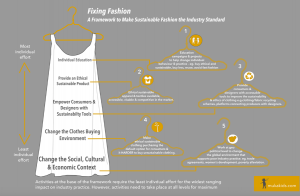Over the past 3 blog posts we have seen how the fashion industry needs to urgently change, and how it is showing promising signs that it is, albeit slowly, starting to become more sustainable. In our final instalment however, we ask how much are we, the public, willing to change our own lifestyle to help?
By Nadin Moustafa, PhD student in the Department of Chemical Engineering.
Many brands are working towards increasing sustainability in their supply chain by using sustainable cotton and/or fabric initiatives to reduce water, energy and chemical use. Some brands are implementing new dyeing technologies to reduce water consumption as well as other energy and chemical saving schemes throughout their supply chain. Such work has decreased carbon and water footprints of clothing in the UK by 8% and 7%, respectively since 2012 (WRAP, 2017).

Consumers’ perspective
Thus, the industry seems to be working towards decreasing their environmental impact. However, from our perspective, consumption in the UK increased by 10% since 2012 (WRAP, 2017). And not only are we buying more clothes – we are also discarding our clothes a lot quicker. A survey done by Drapers also showed that although consumers are more aware of the problem, we are not necessarily willing to pay extra for sustainable products (Drapers, 2019). Our behavior is actually more selfish than we’d like to think. Rational models of consumption assume that individuals make choices by balancing costs and benefits. Hence, ideally, an ethical consumer would consider the best outcome of costs and benefits for them AND the environment. However, real consumption and especially fashion consumption is not ideal. In fact, it is quite irrational. We tend to buy clothes for many reasons such as pleasure and excitement, setting status and sometimes just because it is too cheap not to!
It can be assumed that consumers would take decisions to decrease their environmental impact if they are more aware of the devastating environmental effects. However, research shows that this is not necessarily true. In fact, being bombarded with more information tends to reduce the influence of ethical issues due to the complexity of information faced by the consumer (Kaplan, 2000). The amount of different information coming from different sources makes it easier for a consumer to dismiss the issue and buy that awesome shirt on sale.
An alternative approach is to recognize that fast fashion is desirable and hence, develop and innovate methods that would enable the industry to decrease its environmental impact economically whilst maintaining fast fashion to the consumer.

What can you do to help?
A very important question that may have crossed your mind then is: what can I, as a consumer do to help towards this problem? Here are some of many suggestions!
- Choose fibers with low water consumption such as linen or recycled fibers since
- 5 trillion liters of water is used by the fashion industry ever year, while 750 million people in the world do not have access to water.
- Choose natural or semi-synthetic fibers. Wash clothes only when you need to and at a lower temperature.
- 190,000 tons of textile microplastic fibers go into the ocean every year.
- Buy less, invest in better quality and recycle
- The equivalent of 1 garbage truck of clothes is dumped into a landfill every second.
- 10% of global emissions comes from the fashion industry
- 400% more carbon emissions are produced if we wear a garment 5 times instead of 50 times.
- Choose organic fibers, support sustainable brands.
- 23% of all chemicals produced worldwide is used in the fashion industry!!!!
- 20,000 people die of cancer and miscarriages every year as a result of chemicals sprayed on cotton
- Cotton production uses 24% and 44% of insecticides and pesticides produced globally.
Bibliography
WRAP, 2017. Valing Our Clothes: the cocst of UK fashion. [Online]
Available at: http://www.wrap.org.uk/sites/files/wrap/valuing-our-clothes-the-cost-of-uk-fashion_WRAP.pdf
Drapers, 2019. Drapers research: how sustainable is the fashion industry. [Online]
Available at: https://www.drapersonline.com/companies/drapers-research-how-sustainable-is-the-fashion-industry
Kaplan, S., 2000. Human Nature and Environmentally Responsible Behaviour. Journal of Social Issues, 56(3), pp. 491-508.
Backstage tales, 2017. Why fast fashion needs to change. [Online]
Available at: https://www.backstagetales.com/fast-fashion-needs-change/
IBISWorld, 2018. Thoughtful Threads: Ethical Consumerism and Fashion. [Online]
Available at: https://www.ibisworld.com/industry-insider/analyst-insights/thoughtful-threads-ethical-consumerism-and-the-fashion-industry/